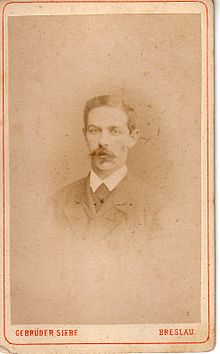George of Caro
Georg von Caro (born June 6, 1849 in Breslau ; † September 22, 1913 at Wilkendorf Castle ) was a German entrepreneur .
family
Georg Caro came from a well-known Jewish-Sephardic family that settled in Silesia . He himself was baptized a Protestant . His father Robert Caro (1819-1875) was the local merchant and cabin owner in Wroclaw and partners there, from his father Isaac Moritz Caro in 1807 launched the company M. I. Caro sons iron trade , he carried the honorary title of Commerce . Georg Caro's mother Hermine Caro née Kern (1826–1889) was a daughter of the Brno businessman Samuel Kern.
Oscar Caro (1852–1931), one of his brothers, was considered an important leader in Upper Silesian industry. He was the owner of the Herminenhütte founded by his father in Laband near Gleiwitz and a partner in the Gleiwitz wire factory Heinrich Kern & Co. Two other brothers were the composer Paul Caro (1859-1914) and the writer Carl Caro (1850-1884).
Caro was married twice, her first marriage in 1881 to Julie Mathilde née May (1856–1900), after whose death in 1902 May was widowed with Karoline Esser (* 1875). The daughter he adopted from his second wife's first marriage, Adele Caro-May, was raised to the Prussian nobility in September 1910 . She was married to the Dutch Legation Secretary Dr. A. W. Mosselmans.
Life
Georg Caro attended the Maria-Magdalenen-Gymnasium in Breslau from 1859 to 1867 . After graduating from high school , he began studying law at the Ruprecht-Karls-Universität Heidelberg . In 1868 he moved to the Silesian Friedrich Wilhelms University in Breslau , and in 1869 to the Friedrich Wilhelms University in Berlin . Caro was a member of the Corps Rhenania Heidelberg and Borussia Breslau , where he was active with Waldemar Dyhrenfurth and Ernst Remak .
He took part in the Franco-Prussian War as a reserve lieutenant in the Leib-Kürassier Regiment No. 1 , a highly respected unit in which civil officers were rare and those of Jewish origin the exception. He then did his doctorate as Dr. jur. at the Ernst Moritz Arndt University of Greifswald . His father died in 1875. Georg Caro took over his father's iron wholesaler, which he expanded into one of the largest companies of its kind in Germany.
In 1883 Georg Caro and his brother Oscar acquired the Julienhütte in Bobrek near Beuthen , which has since been known as Georg and Oscar Caro, Bobrek blast furnace . 1887 the work with the company was Heinrich Kern & Co. of Hermione hut in Laband and the Baildon Steelworks in Katowice to the Upper Silesian iron industry AG of Mining and Metallurgical Plant merged . Oscar Caro became general manager and sole board member of the new company. Georg Caro was a member of the supervisory board until his death, as was the case with the Eisenhütte Silesia AG, which he founded . On January 1, 1910, he set up the Deutsche Eisenhandels-AG in Breslau , which brought together the relevant departments of the companies M. I. Caro & Sohn (Breslau), Eduard Lindner (Breslau) and Jacob Ravené (Berlin). In addition, the group had over 40 subsidiaries throughout Germany. At Caro's death he had a capital of 23 million marks and an annual turnover of over 120 million marks.

Georg Caro has received several awards for his entrepreneurial commitment, including the honorary title of Privy Councilor of Commerce . On February 27, 1906, he was raised to the Prussian nobility . After buying the manor estates of Wilkendorf Castle near Strausberg (1250 ha ) and Gielsdorf (1350 ha) east of Berlin, he became the founder of a family entrenchment there . In 1910 he received the Royal Order of the Crown, 2nd class.
Georg von Caro died in 1913 at the age of 64 at Wilkendorf Castle. He was buried in the family mausoleum on Cemetery II of the Jerusalem and New Churches in front of the Hallesches Tor in Berlin. The preserved tomb in the neo-renaissance style is modeled on an ancient temple. It was built in 1901 and is based on a design by the architects Kayser & von Großheim .
literature
- Leo Lustig : Georg von Caro . In: Annual report of the Silesian Society for Patriotic Culture . No. 91 , 1913, pp. 6-8 (Nekrolog).
- Alfons Perlick : Upper Silesian miners and smelters. Pictures of life from the Upper Silesian industrial area . Holzner, Kitzingen 1953, p. 79-81 .
- Caro (family item). In: New German Biography (NDB). Volume 3, Duncker & Humblot, Berlin 1957,ISBN 3-428-00184-2, p. 152 f. ( Digitized version ).
Web links
Individual evidence
- ↑ Kösener Corpslisten 1930, 70 , 178; 18 , 525
- ^ Hans-Jürgen Mende : Lexicon of Berlin burial places . Pharus-Plan, Berlin 2018, ISBN 978-3-86514-206-1 , p. 231. Cemetery I and II of the Jerusalem and New Churches . Description of the cemetery in the database of the Berlin State Monuments Office. Accessed March 24, 2019.
| personal data | |
|---|---|
| SURNAME | Caro, Georg von |
| BRIEF DESCRIPTION | German coal and steel entrepreneur |
| DATE OF BIRTH | June 6, 1849 |
| PLACE OF BIRTH | Wroclaw |
| DATE OF DEATH | September 22, 1913 |
| Place of death | Wilkendorf Castle |

